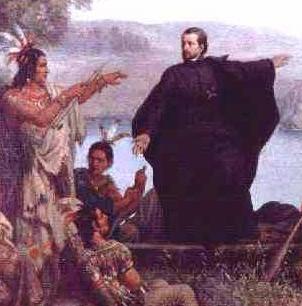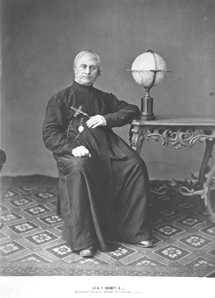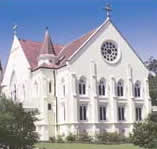Spotlight Archive
On December 3, 2006, the Jubilee Year of the Society of Jesus came to a close. The Jubilee Year commemorates events in the lives of three founding members of the order: 450 years since the death of Ignatius of Loyola, and 500 years since the births of Francis Xavier and Peter Faber.
Jesuit priests were among the first Catholic missionaries to what would become the United States, arriving in Virginia just a decade after the death of Ignatius Loyola.
 Fathers Isaac Jogues and John Lalande worked among the Huron in Canada and upstate New York. They were killed by Iroquois in 1646. Jacques Marquette explored and evangelized in the Great Lakes region, while Eusebio Kino did the same in the Southwest. Sebastien Râle worked among the Abanaki in Maine, among whom he died at the hands of a sortie of British colonists. Jesuits administered early Catholic churches such as the brick chapel at St. Mary's City and St. Joseph's in Philadelphia.
Fathers Isaac Jogues and John Lalande worked among the Huron in Canada and upstate New York. They were killed by Iroquois in 1646. Jacques Marquette explored and evangelized in the Great Lakes region, while Eusebio Kino did the same in the Southwest. Sebastien Râle worked among the Abanaki in Maine, among whom he died at the hands of a sortie of British colonists. Jesuits administered early Catholic churches such as the brick chapel at St. Mary's City and St. Joseph's in Philadelphia.
 The Jesuit mission in America was complicated but not halted by the suppression of the order by Pope Clement XIV in 1773. Priests such as John Carroll were no longer formally a part of the Society of Jesus, but they carried on with their ministry to the small communities of Catholics on the Atlantic seaboard. Carroll was widely respected and served on a diplomatic mission to Canada on behalf of the fledgling nation. He would later become the first American bishop. Pierre Gibault served the Catholics of Indiana, whom he organized in favor of the American cause during the Revolution. The society was reinstated by Pope Pius VII in 1814 and Jesuit priests such as Pierre De Smet continued mission activity in the less settled areas of the new country.
The Jesuit mission in America was complicated but not halted by the suppression of the order by Pope Clement XIV in 1773. Priests such as John Carroll were no longer formally a part of the Society of Jesus, but they carried on with their ministry to the small communities of Catholics on the Atlantic seaboard. Carroll was widely respected and served on a diplomatic mission to Canada on behalf of the fledgling nation. He would later become the first American bishop. Pierre Gibault served the Catholics of Indiana, whom he organized in favor of the American cause during the Revolution. The society was reinstated by Pope Pius VII in 1814 and Jesuit priests such as Pierre De Smet continued mission activity in the less settled areas of the new country.
Other than missions, the most significant legacy of the Jesuits in the United States lies in the field of education. Jesuit high schools are present in almost every major city, often commanding reputations as the finest academic institutions. In many cases, the high schools date to the early settlement of their respective regions. As American education developed, many of these schools were split into two instutitions, thus giving rise to Jesuit colleges and universities.
 Georgetown College (1789) was the first Catholic tertiary school, and among the earliest of the country’s colleges. Fordham (1841) and Boston College (1863) gave Catholics academic footholds in the nation’s leading centers of finance and learning. Jesuits pioneered Catholic education in places such as the South (Spring Hill College, Mobile, 1830), the new cities of the Midwest (St. Louis, 1818; Xavier, Cincinnati, 1831; Loyola, Chicago, 1870; and Creighton, Omaha, 1878) and the Pacific Northwest (Gonzaga, Spokane, 1887).
Georgetown College (1789) was the first Catholic tertiary school, and among the earliest of the country’s colleges. Fordham (1841) and Boston College (1863) gave Catholics academic footholds in the nation’s leading centers of finance and learning. Jesuits pioneered Catholic education in places such as the South (Spring Hill College, Mobile, 1830), the new cities of the Midwest (St. Louis, 1818; Xavier, Cincinnati, 1831; Loyola, Chicago, 1870; and Creighton, Omaha, 1878) and the Pacific Northwest (Gonzaga, Spokane, 1887).
Jesuits sponsored a number of significant periodicals. They founded America magazine in 1909 and the scholarly journal Thought in 1926. The preeminent American theology journal, Theological Studies, began publication in 1940.
Given their prominent place in higher education and publishing, Jesuits were naturally among the foremost American Catholic theologians and intellectuals. Georgetown professor James Curley was an early American astronomer. Daniel Lord was a prolific writer who also advised Hollywood movie makers about pictures involving Catholic themes. Moorhouse Millar was a church-state theorist who co-wrote an important text in the 1920s. His ideas were revised by John Courney Murray, who became a celebrity theologian when he was featured on Time magazine in 1960. Edmund Walsh founded Georegetown’s School of Foreign Service and was a notable anti-Communist in the 1950s. Avery Dulles, a leading American theologian for four decades and a professor at Fordham, was honored with a cardinalate in 2001.
With the rest of American Catholicism, Jesuits underwent crisis and change following Vatican II. Its membership fell from almost 6,000 priests in the 1960s to approximately half that number today. Jesuits were already leading advocates of racial justice: John LaFarge and William Markoe differed in their approach, but both were ahead of their time. Exhibiting greater focus on social issues following the Council, some Jesuits took the new direction to radical lengths. Daniel Berrigan was repeatedly arrested in the course of protesting the war in Vietnam. Againt the wishes of Rome, Robert Drinan entered U.S. Congress as a Democrat and became a champion of liberal social policy.
Jesuits were also prominent, however, among conservatives who opposed theological dissent. Joseph Fessio and Earl Weis were among the first officers of the Fellowship of Catholic Scholars; Fessio, a former administrator at the University of San Francisco also founded the self-consciously orthodox Ignatius Press.
Notwithstanding a recent history of declining numbers and influence, talented young men continue to be drawn to the society that has produced some of America’s most notable clergy. The future is always uncertain, but the past is undeniable: Jesuit individuals and institutions have exerted significant and ongoing influence on the development of the Church in the United States.
Photos, from top: Jacques Marquette (public domain); Pierre De Smet (courtesy of Washington State University); Spring Hill College (courtesy of Spring Hill College)
Sources and Further Reading
